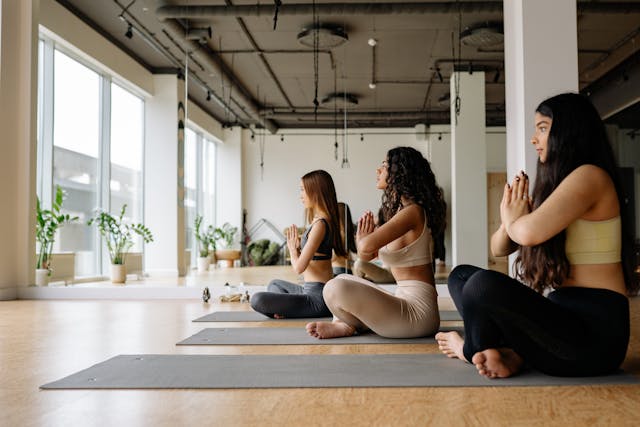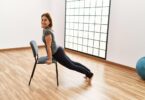Table of Contents
Introduction
Have you ever wondered what it would be like to do yoga with two of your friends? 3-person yoga, or triple yoga, is a fun and challenging way to practice yoga that involves three people working together to create beautiful and complex poses. Not only does it look impressive, but it also comes with a host of benefits, like improved balance, increased strength, and a deeper sense of connection with your partners.
Getting Started
Before diving into the poses, it’s important to find the right partners. Ideally, these should be people you feel comfortable with and who are at a similar fitness level. Once you have your team, set up a space that is spacious enough for movement and has a soft surface, like yoga mats or grass.
Safety First
Safety First Three-Person Yoga Poses
- Three-Person Downward Dog Pyramid
- Position: Person A gets into Downward Dog with hands and feet on the ground, forming an inverted V shape.
- Support: Person B places their hands on the ground in front of Person A and their feet on Person A’s lower back, forming another Downward Dog.
- Stability: Person C places their hands on the ground in front of Person B and their feet on Person B’s lower back.
- Safety Tips: Each person should maintain a strong core and communicate throughout the pose to keep balance and prevent strain.
- Three-Person Partner Boat Pose
- Position: All three participants sit in a circle with legs extended and feet touching in the center.
- Support: Each person holds the hands of their neighbors for stability.
- Lift: Together, they lift their legs to form a shared Boat Pose.
- Safety Tips: Keep the back straight and engage the core to protect the lower back. Use each other’s support to maintain balance.
- Triple Warrior III
- Position: Person A stands in Warrior III with one leg extended back and arms reaching forward.
- Support: Person B stands behind Person A, placing their hands on Person A’s shoulders and mirroring the Warrior III pose.
- Balance: Person C stands behind Person B, placing their hands on Person B’s shoulders and also mirroring the Warrior III pose.
- Safety Tips: Maintain a straight line from head to extended foot, and keep the supporting leg strong. Communicate to adjust the balance as needed.
These poses focus on safety by emphasizing communication, core engagement, and mutual support among participants.
Related Article: For beginners looking to start their yoga journey, check out our guide to yoga for beginners.
Basic Poses
Base and Flyer Roles
In 3-person yoga, each person typically takes on one of three roles: base, flyer, or spotter. The base is the foundation, providing support and stability. The flyer is lifted or balanced on the base, while the spotter ensures everyone’s safety and helps guide the poses.
Pose 1: Triple Downward Dog
This pose is a great starting point for beginners.
- Step-by-Step Instructions:
- Person A gets into a downward dog position.
- Person B places their hands on Person A’s lower back and steps into their own downward dog.
- Person C places their hands on Person B’s lower back and steps into a downward dog.
- Common Mistakes:
- Not aligning hands and feet properly.
- Lack of communication during setup.
Pose 2: Triangular Bridge
Another simple yet effective pose.
- Step-by-Step Instructions:
- Person A lies on their back and lifts their hips to form a bridge.
- Person B sits on Person A’s thighs and leans back, placing their feet on the ground and hands-on Person A’s knees.
- Person C stands behind Person B, holding their shoulders for support.
- Common Mistakes:
- Inconsistent weight distribution.
- Not maintaining a straight line from shoulders to knees.
Intermediate Poses
Pose 3: Three-Way Plank
This pose requires more strength and balance.
- Step-by-Step Instructions:
- Person A gets into a plank position.
- Person B places their hands on Person A’s ankles and their feet on Person A’s shoulders, forming a plank.
- Person C places their hands on Person B’s ankles and their feet on Person B’s shoulders, forming the top plank.
- Common Mistakes:
- Not engaging the core muscles.
- Misalignment of the planks.
Pose 4: Human Pyramid
A classic and visually impressive pose.
- Step-by-Step Instructions:
- Person A kneels on all fours.
- Person B kneels on Person A’s back and gets into a plank position.
- Person C stands on Person B’s back and extends their arms up.
- Common Mistakes:
- Rushing into the pose without proper balance.
- Not using spotters for safety.
Related Article: Explore more advanced yoga poses to elevate your skill level.
Advanced Poses
Pose 5: Elevated Triangle
This pose is for advanced practitioners who have built significant strength and trust.
- Step-by-Step Instructions:
- Person A and Person B stand facing each other and clasp hands.
- Person C is lifted into a side plank position on the arms of Person A and B, creating a triangle.
- Common Mistakes:
- Inadequate arm strength.
- Poor coordination between partners.
Pose 6: Triple Warrior
A powerful and dynamic pose that showcases strength and balance.
- Step-by-Step Instructions:
- Person A gets into Warrior II pose.
- Person B climbs onto Person A’s thigh and extends into their own Warrior II.
- Person C climbs onto Person B’s thigh and extends into their Warrior II.
- Common Mistakes:
- Losing balance during transitions.
- Misaligning hips and shoulders.
Cool Down and Stretching
Cool Down and Stretching Poses for Three People
- Triangle Trio Stretch
- Person A stands with legs wide apart, reaching one hand to the floor and the other toward the ceiling, forming a triangle shape.
- Person B mirrors Person A’s pose on the opposite side.
- Person C stands between them, reaching arms out to hold each person’s extended arm. This forms a connected triangle.
- Triple Child’s Pose
- Person A starts in Child’s Pose, sitting back on their heels with arms extended forward.
- Person B and Person C each place one hand on Person A’s back while stretching their other arm forward, also in Child’s Pose.
- This creates a supportive, grounding position where all three participants are connected.
- Supported Forward Fold
- Person A stands with feet hip-width apart, bending forward to touch their toes.
- Person B and Person C stand behind Person A, placing their hands on Person A’s lower back and providing gentle support.
- B and C then also bend forward, creating a supportive chain of forward folds.
- Seated Spinal Twist Circle
- All three participants sit in a circle, legs crossed.
- Person A places their right hand on Person B’s left knee and their left hand behind their back.
- Person B places their right hand on Person C’s left knee and their left hand behind their back.
- Person C places their right hand on Person A’s left knee and their left hand behind their back.
- Together, they twist their upper bodies gently, supporting each other in the stretch.
- Three-Person Cobra Pose
- All three participants lie on their stomachs side by side.
- Person A places their hands on the floor near their shoulders and gently lifts their upper body into Cobra Pose.
- Person B and Person C do the same, with their arms slightly overlapping, providing mutual support.
- This allows each person to stretch their back and shoulders together.
- Mutual Hamstring Stretch
- Person A sits with legs extended forward.
- Person B and Person C sit facing Person A, each with one leg extended to form a triangle.
- All three participants reach for each other’s hands, holding onto their partner’s opposite hand to stretch their hamstrings.
These poses help relax and stretch multiple muscle groups, fostering a sense of connection and teamwork among participants.
Related Article: Learn about the benefits of chair yoga and how it can enhance your practice.
FAQs
What are the three steps of yoga?
Three Steps of Yoga:
Asanas (Postures): These are physical exercises involving various poses that improve strength, flexibility, and balance.
Pranayama (Breathing Techniques): These are controlled breathing exercises designed to calm the mind and improve energy flow.
Meditation: Techniques used to focus the mind and achieve a state of mental clarity and emotional calm.
What is a Yoga Pose?
A yoga pose, or asana, is a specific physical position practiced in yoga. Each pose has a distinct name and form, intended to target different parts of the body and mind.
How Many Poses Are in Yoga?
Yoga includes a vast number of poses. Traditional yoga texts mention as many as 84 classic asanas, but modern yoga practice includes hundreds of variations and new poses.
Is Lotus a Yoga Pose?
Yes, the Lotus Pose, or Padmasana, is a well-known yoga pose. It involves sitting with crossed legs, with each foot placed on the opposite thigh, and is commonly used for meditation.
Conclusion
3-person yoga is a rewarding and challenging way to practice yoga. It builds strength, improves balance, and fosters a deep connection with your partners. So grab your friends, find a suitable space, and start practicing these poses today. Remember, the journey is just as important as the destination.







